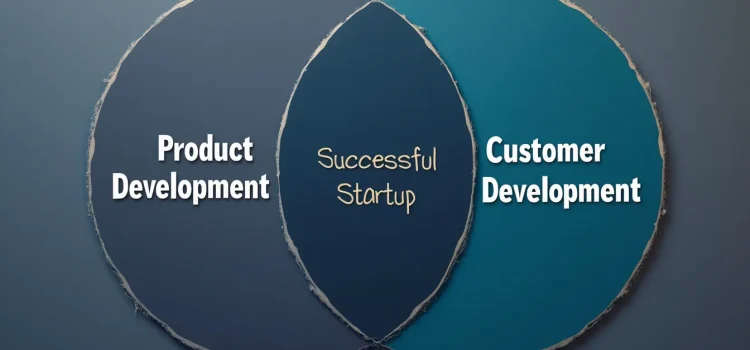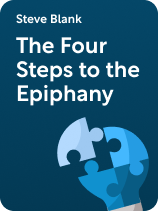

This article is an excerpt from the Shortform book guide to "The Four Steps to the Epiphany" by Steve Blank. Shortform has the world's best summaries and analyses of books you should be reading.
Like this article? Sign up for a free trial here.
What makes startups different from established companies when it comes to product launches? Why do traditional product development methods often fail new ventures?
Steve Blank’s customer development methodology offers a revolutionary approach for startups. His framework helps new ventures validate their market assumptions and build sustainable business models while developing their products.
Keep reading to discover how combining product development with customer development can dramatically improve your startup’s chances of success.
Steve Blank on Customer Development
According to Steve Blank, customer development is too often neglected by entrepreneurs. He explains that most startups launch using a product development process, through which they focus primarily on refining their offering. This process consists of four steps: 1) conceiving of the product, 2) developing the product, 3) testing the product, and 4) launching the product. This model is an effective way to launch a new product when a company already knows its market, competition, and customer base. It’s therefore used—often successfully—by large, established companies.
Startups, however, can’t rely on the same process as large businesses because the process assumes a level of market knowledge and certainty that most new ventures don’t have. Therefore, Blank recommends that startups complement their product development process with a customer development process. Like product development, it boils down to four steps: 1) finding your customer base, 2) verifying your customer base, 3) acquiring customers, and 4) establishing and scaling your business. Unlike product development, it focuses first on customer characteristics and needs rather than on product features.
Blank writes that product development and customer development should occur simultaneously, but the customer development process should shape a startup’s business model.
(Shortform note: In The Lean Startup, Eric Ries introduces the concept of validated learning, which aligns with Blank’s customer development process. This approach involves quickly building a minimum viable product (MVP) and gathering customer feedback to guide further development. Ries argues that this iterative process allows startups to learn about their customers and market more efficiently than traditional product development methods. By combining Blank’s customer development with Ries’s validated learning, startups can potentially reduce the risk of building products that customers don’t want.)
Whereas product development focuses on launching a product, customer development prioritizes understanding customers and their needs from the very beginning. Blank emphasizes that customer development isn’t simply a sales or marketing process but a distinct set of activities aimed at proving market existence, verifying customer willingness to pay, and creating the market itself. It’s a process of learning about your customers and their problems, which Blank argues should occur as early in the startup process as possible.
(Shortform note: The emphasis on understanding customers and their problems echoes the principles of the “Jobs to Be Done” theory, detailed by Clayton Christensen in Competing Against Luck. This theory posits that customers “hire” products to perform specific jobs in their lives. By focusing on these jobs rather than on customer demographics or product attributes, startups can gain deeper insights into customer needs. Christensen argues that this approach leads to more innovative and successful products. Integrating the “Jobs to Be Done” framework into Blank’s customer development process could provide startups with an additional method for uncovering and addressing customer needs.)
Pitfalls of Product Development Without Customer Development
Blank highlights some of the ways in which relying exclusively on product development (without customer development) can lead startups to fail.
Pitfall #1: Focusing Too Much on the End Goal
Blank explains that product development focuses on creating, launching, and shipping the product. This focus fails to account for the huge amount of work that needs to be done before you can reach these end stages—namely, learning about and building your customer base. No matter how great your product is, your company won’t succeed if you don’t have customers.
(Shortform note: The pitfall of focusing too much on the end goal is a “planning fallacy.” This is a cognitive bias in which people tend to underestimate the time, costs, and risks associated with future actions while overestimating the benefits. This fallacy can lead startups to overlook crucial steps when launching a product. By acknowledging the planning fallacy, startup founders can adopt a more realistic approach to their timelines and resource allocation, potentially avoiding this pitfall.)
Pitfall #2: Different Milestones & Lack of Pacing
Product development and customer development also progress according to different milestones, which means they require different pacing. Blank warns that if you adhere to the milestones of product development while skipping the milestones of customer development, you risk setting an improper pace for your company. This might lead to, for example, hiring and expanding too quickly based on optimistic projections of customer interest that fail to materialize.
According to Blank, the product development process is linear and follows a predictable pattern with easy-to-measure objectives. For example, you know you’ve hit your stage 2 milestone when you’ve created a product that works—a clear-cut and understandable metric.
(Shortform note: While product development milestones tend to be more clear-cut than customer development milestones, businesses may still find it challenging to define and act on them. Measuring progress by milestones requires you to understand which metrics are the most important for your product. Product managers recommend identifying a “North Star” metric that defines success for a specific product and then aligning other metrics to support it. For example, subscription-based products may need to focus on Monthly Recurring Revenue, and a business that offers free trials or demos of their product may need to focus on conversion rates to measure their progress.)
In contrast, says Blank, customer development has more subjective, nebulous milestones. It’s much more difficult to determine that you fully understand your customers than it is to ascertain whether a product works on a basic level. To measure progress using the customer development model, startups thus must use qualitative, rather than quantitative, metrics. For example, instead of sales numbers, they might measure progress by answering questions like, “do we understand our customers’ problems?” or “do we know which desires our customers value most?”
| Avoiding Vanity Metrics In The Lean Startup, Eric Ries explains that businesses often make the mistake of relying on “vanity metrics” (such as number of followers) in customer development. These metrics look good but provide a false sense of progress without offering meaningful insights. Instead, Ries suggests focusing on actionable metrics that more accurately reflect a company’s core value proposition and growth strategy. These might include user engagement levels, customer retention rates, and conversion rates at key steps in the customer journey. Furthermore, Ries recommends using cohort analysis and A/B testing to gain more accurate insights into customer behavior and preferences. This approach can provide more meaningful measures of progress in customer development. |
Pitfall #3: Lack of Customer Feedback in Marketing
The product development process also lacks a means of collecting feedback from customers to inform marketing practices, explains Blank. Marketing begins early on in product development to ensure there’s a demand. This includes activities such as creating sales materials and hiring public relations staff. However, since sales haven’t yet begun at this point, companies aren’t able to garner and incorporate feedback from real customers. This can lead to wasted resources and marketing campaigns that fail to resonate with the target market.
| Using Customer Feedback to Craft a Marketing Story Seth Godin’s marketing advice in All Marketers Are Liars underscores the importance of gathering and implementing customer feedback to inform marketing. According to Godin, successful marketing is not about creating a perfect product and then trying to sell it, but rather about telling a story that resonates with customers. He argues that marketers should focus on creating and spreading ideas that people want to believe and share. This approach requires a deep understanding of the target audience, which can only be achieved through continuous feedback and interaction. Godin suggests that companies should be willing to adapt their marketing strategies based on customer responses, rather than sticking to a predetermined plan. This flexibility allows businesses to create more authentic marketing campaigns that connect with their intended audience. |

———End of Preview———
Like what you just read? Read the rest of the world's best book summary and analysis of Steve Blank's "The Four Steps to the Epiphany" at Shortform.
Here's what you'll find in our full The Four Steps to the Epiphany summary:
- The four different types of startup markets
- How to identify customer interest in your product
- The three key actions necessary for a startup to grow






